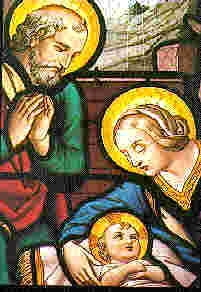
of the nativity of Lord Christ.
|
by Sudheer Birodkar________________________________________________________
_________________________________________________
 | A stained glass representation of the nativity of Lord Christ. |
In talking of Christianity one generally loses sight of the fact that it was born in Asia and thus to begin with it is an oriental religion. Jesus Christ whose name the religion bears was born in Bethlehem in what is today the state of Israel.
"Among ancient legends there is one told of a little boy who once amused himself at play by modeling images of sparrows. As he was delighted with his creations. He clapped his hand whereupon the little birds took fright and flew away." This story of the child Jesus was one of the most popular of the many infancy narratives which the early Christians told about their leader.
(Charles F. Potter; The Story of Religion: George G.Harrap and Co. Ltd., London 1960 P. 181)
Magis - Zoroastrian Priests?
Like that of many other prophets the birth of Jesus was foretold through an angelic announcement. This announcement we are told brought forth three Zoroastrian priests from ancient Persia to pay their homage to the divine babe, as they interpreted the angelic announcement as heralding the birth of a Zoroastrian apostle. The three priests referred to as Magi (from Magian - a name for the ancient Zoroastrians) were also spoken of ' as three wise men or three kings from the east who brought gifts to the child Christ. But this angelic announcement that there is born Jesus 'king of the Jews' also eventually had repercussions when the news reached the tyrant Herod who was then the actual king of the Jews in Palestine.
The birth of another King' within his kingdom seems to have frightened him and in a effort to destroy this new 'King' he decreed that all babies in this kingdom should be killed. But, Jesus was saved as his parents whisked him away to Egypt outside Herod's kingdom. Most of Jesus' early childhood was spent in Nazareth.
When he was still a young boy of around 12 years his parents viz., his mother the Virgin Mary and his foster-father Joseph took him to Jerusalem for the spring time religious feast of the Passover. At the end of the first days journeying homewards they missed him. After searching for two days they found him in the Temple at Jerusalem, discussing theology with the learned doctors, impressing them with his wisdom and comprehension.
(Much has been said about Mary being referred to as a Virgin and Joseph as his foster father. The question is posed as to who was Jesus' real father.
Such questions are also asked in the case of Kunti and her son Karna in the Mahabharata epic of the Hindus. For the devout the scriptural explanation of Virginity should suffice but for more critical students of history these questions call for an answer if human standards are applied to the scriptural accounts.)
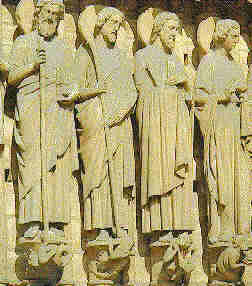
| A Bas relief from an early church representing the Apostles of Christ. |
Biographers of Jesus talk of the 18 silent years of his life, referring to the time between the incident in the temple when he was 12 years old and his baptism by John at the age of 30. To this important period of his life the Gospel sources devote but one sentence, Luke' s statement that he increased in wisdom and stature and in favour with God and man. But this statement only says that he was a normal youth and young man."
Christ and Sri Krishna
But according to some scholars Jesus visited Kashmir in India in this period and during his stay conversed with Sages in India. It is also said on his death, his body was brought into Kashmir where it lies buried in a Shrine which bears the Arabic version of his name i.e. Isa. Some others even confound Christ with Krishna and assert that both were one and the same person. As both were born in a pastoral setting, the birth of both was foretold by a divine announcement, the reigning king (Kansa in the case of Krishna) felt threatened with the birth of the God-Child, the reigning king made efforts to kill the child, the reigning king killed other children, the God-child was whisked away to safety across a water body, etc. And above all the name Isa (Jesus) Christ is a corruption of Esha (Lord) Krishna. But so far no conc1usive proof , has been found to support this far-fetched theory.
Coming back to Jesus, after his baptism he continued preaching his gospel in doing which he also acquired the role of a healer of diseases due to the sick people whom he cured in the course of his preachings. He had twelve select disciples one of whom was named Judas. As the teachings of Jesus gradually brought him into conflict with the Jewish religious establishment who contrived with the Roman an authorities to execute Jesus. In this they were helped by Jesus' own disciple Judas who betrayed him for the sake of a few silver coins. Jesus was thus held prisoner, he was tried by a Roman Court of law and sentenced to death. Before his execution he had his last meal (supper) with his disciples, at which he reiterated his preachings.
The last supper' is an incident popularly engraved into Christian psyche second only to the crucifixion. After Jesus was put to death on the cross, we are told, that after three days he was resurrected from his grave, after which he preached from some more days before passing into eternity.
Chrisianity's umbilical cord with Judaism
But Christianity and Christians were not a distinct religion different from Judaism. They were mainly Jews who looked upon Jesus as their leader but who had not detached themselves from Judaism. Even after the passing away of Jesus Christ, his teachings spread only in the Jewish quarters of cities outside Palestine. It was at Antioch in Syria where for the first time the Gentiles or Non-Jewish people were preached the teachings of Christ. In the liberal atmosphere of Antioch the teachings of Christ grew rapidly among the non-Jewish population.
Now the question arose whether these non-Jewish followers of Jesus Christ should first be converted to Judaism - as Christ was himself till then looked upon as a Jewish Reformer of Judaism. The answer to this question was decided upon at Antioch itself sometime in the 3rd century during at ecclesiastical conference. At this conference it was decided. that the followers of Jesus Christ were not a Jewish sect but constituted an international religion. It was also decided that the non-Jewish converts to the new faith need not adopt the Jewish faith, they need not practice circumcision, nor follow the law of Moses in toto. This made the disciples of Jesus Christ a new faith, distinct from its parent faith Judaism. The faith spread rapidly due to missionary activities amongst the laity in the Roman empire.
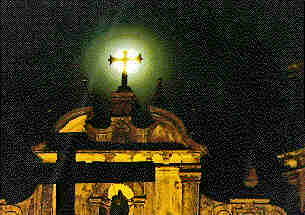
| The Church of St. Francis of Assisi. In the year 1510 C.E., Alfonso De Albuquerque captured Goa. He established Portuguese Rule that was to last for over 450 years till the liberation of Goa by the Indian army in 1962. |
Incorporation of Christianity as the Roman State Religion
The next step was taken after the nominal conversion of the Roman Emperor Constantine to Christianity following the conversion of most of the Roman laity to the new religion. This process was not smooth, as his son, relapsed into the old Roman beliefs and was called the "Apostate" in Christian Chronicles. But Constantine's grandson was a devout Christian and was called the "Pious".
Roman Influences on Christianity
The result of this back and forth movement in matters of faith in the Roman royal family was that it eventually led to the abandonment of Hebrew and the acceptance of Latin as the ecclesiastical language and Rome as against Jerusalem as the ecclesiastical center where the papacy was founded and was based at Rome the heart and capital of the (Roman) empire as also the rewriting of the Bible as the New Testament different from the original O1d Testament of the Jews. This completed the breach between the faith of Jesus and Judaism. But in driving this wedge the influence of the Roman empire should not be lost sight of as after the conversion of the Roman Royal family followed by the Roman nobility and finally the remaining Roman laity to Christianity. The occidental Roman empire was naturally interested in shearing away of the oriental roots of a faith which it had made its state Religion. From then onwards Christians and Christianity became synonymous with Europe and Europeans.
Christianity in India 40 years after Christ
But as mentioned earlier in this chapter, Christianity originally came to India before it reached many of the West European Christian countries of today. It is supposed to have reached India between the 1st and 3rd centuries of our era. But these early attempts to introduce Christianity into the country could make any major dent. Only small pockets in the South were converted and are today's Syrian Christians mainly from Kerala and some parts of Tamil Nadu.
These Christians mostly come from the Namboodri Brahmin caste of Kerala. They represent an interesting sociological entity. Devout Christians as they are, they are also stout-hearted nationalists with a strong Malayali identity which translates to a strong national (Indian) identity. Hypothetically speaking, if all Indians had been converted by the Apostle St. Thomas to Christianity all Indians might have been like (the prototype) Syrian Christian Community - Christian yet specifically national.
Portuguese Bring Christianity (as Catholicism) into Goa
Christianity (as Catholicism) into Goa came into our country in a large way only after the 15th century alongwith the Portuguese Colonists. The Portuguese were Roman Catholics and when they reached Indian shores were still under the influence of the crusades and. the inquisition. In the early centuries of their rule in Goa, Daman and Diu they did make the use of force to effect conversions of the native Hindus to Christianity. A part of the early converts to Christianity were a result of the taking of Indian wives by the Portuguese officials. These converts were termed Mestizos (of mixed blood). To these were added the progeny of extra-marital relations between the colonial officials and the native womenfolk. The offspring of such relations were brought up as Roman Catholics. These facts have been recorded in the Portuguese records of the Colonial Period. The occurrence of aquiline features and fair skin in some Goan Christian families seems to be an inheritance of such relations.
In the early part of Portuguese rule, the Colonialists are also recorded to have forcibly converted temples into churches. As per local traditions in the villages around the Basilica of St. Francis Xavier near Panjim in Goa, There originally existed a Shiva temple on the site of the Basilica which was demolished by the colonial authorities to put up the Basilica. After the Shiva temple was destroyed the local populace constructed a small Shiva-linga nearby in memory of their temple. Till today this Shiva-linga is being worshipped and the age old tale is told to visiting tourists. All this is not being said with a new to unearth long forgotten events, but to record facts of the means used by a colonial power to implant its faith on Indian Soil.
It is well known generally that the Portuguese apart from being ardent proselytizers also observed strict racial segregation and followed a policy of discrimination against all native Indians whether Hindus or Christians. The emigration of some families of Goan Christians to Mangalore in the 16th century was a result of discriminatory treatment by the Portuguese. Even today there exists a significant Konkani speaking Roman Catholic community around Mangalore.
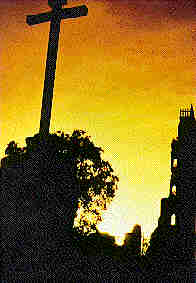
| The Church of St. Augustine . This church was built in 1602 by the colonial administration. Its five storeyed tower is an imposing edifice Most of the colonial churches were built as imposing structures, to overawe the locals. On the keystone of their domes was inscribed the royal insignia of the Portuguese king. An attempt by Portugual to retain the colonial territories was thwarted by the Indian army when it marched into Goa and put an end to colonial rule in 1962. |
The third segment of Indian Christians are the Protestants. They form a minority among the Christian community and are a result of the Protestant Missionaries. The British colonialists largely kept away from proselytizing activities. Conversions to Christianity during British rule were mostly due to the activities of missionaries. Indian Christians have generally not lived a barrack-like existence like the Muslims. There has been a significant social interaction between the Hindus and Christians and the feeling of animosity that exists vis-a-vis the Muslims has been absent in the case of the Christians. As almost all Indian Christians are converts from Hinduism they display many traces of their pre-conversion culture.
Hindu Customs Among the Christian Community in India
To begin with Indian Christians, especially the Protestants have still preserved the surnames of their pre-conversion days. In many cases they also have Hindu first names. This makes them completely identical with the Hindus, at least externally. The reason could partly lie in the fact that many converts to Protestant Christianity were voluntary one's and belonged to the upper echelons of Hindu society. The conversion of the Rev . Vaman Narayan Tilak is one example. These voluntary converts to Christianity turned to that religion consequent to philosophical speculation. It is natural for such converts to preserve a strong nationalistic identity in spite of the conversion.
Marriage Customs Among the Indian Christians
But among all segments of Indian Christians the aspects of their social life, which has preserved their Indian roots as the manner of celebrating Christian festivals especially Christmas and their dress habits.
During Christmas and new Year festivities, it is common among Indian Christians to burst crackers, light lamps, exchange sweetmeats, draw designs with coloured powder outside their doorsteps, etc. All these practices have been a carryover from the Hindu festival of Diwali. If one goes to a Roman Catholic wedding one would see that a day before the wedding is to take place, the groom and his best man are given a special bath by the groom's relatives. In this bath the groom and his best man are smeared with milk, eggs yolk and scents. This custom is no doubt borrowed from the Hinduism where the groom is given a bath with Sandal-wood paste and Turmeric powder, a day before the wedding. The Christian practice of the best man pulling a chord to release a shower of tiny coloured thermocole balls on the bride and groom during the wedding festivities come very close to the Hindu custom of throwing vermillion coloured grains of rice on the couple during a traditional Hindu wedding. Even after the wedding, or after a death in the family, Christians in Goa follow the practice of mass feeding of beggars and poor people, this custom seems to be a carryover of the Hindu custom of feeding brahmins and poor people during any important social and religious function.
Caste among Indian Christians
Conversion to Christianity has not erased the caste system from the Christians. Christians still privately continue to refer to themselves by their caste affiliations like Prabhoos, Bamons, Kolis, Bhandaris, etc. and caste considerations are rarely absent during matchmaking especially among Christians in rural areas. Some Christian converts who were Brahmins originally still in some cases, wear the sacred thread though their number is less. But Christians commonly wear the black thread around their wrist as a good luck charm as do the Hindus. The belief of an evil eye and other taboos persist among the Christians and the method of warding off the effect of the evil eye i.e. Drishta as it is known among Hindus (or Nazar as it is called among the Muslims) is by circling a pinch of salt and chilli powder around the person who is believed to have been affected.
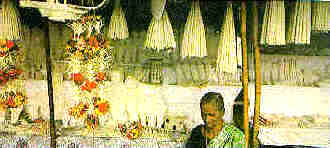
| A vendor selling garlands and replicas of houses, cars, babies, etc. At a shrine at Bandra in Mumbai such replicas are offerred to the icon of mother Mary when asking for a boon for the said object. This practice is an adoption from a similar Hindu practice of asking for boons known as asking for a "vardaan" or "navas" |
Christian women often wear sarees like their Hindu counterparts and some of them even wear bangles and apply the Hindu caste mark, Kum Kum or tilaka on their foreheads. The wearing of the Mangalsutra necklace among Protestant Christian women is obligatory after marriage, as it is among the Hindus. Some Christian families have continued their pre-conversion Practice of praying and asking for boons before Hindu deities during annual Festivals - though this is frowned upon by the Christian clergy.
The traditional Christian form of greeting each other by saying 'Peace be with you' is accompanied by the joining of hands which is an adaptation of the Hindu practice of Namaste. Even when praying Indian Christian carry flowers, and garlands to church. The practice of garlanding the cross and icons is a carryover of the Hindu practice of garlanding idols. In the west this practice is absent where only candles are lit before the Cross.
(Donald Eugene Smith, India as a Secular State, Princeton University Press, Princeton, New Jersey, USA. 1963, P 432)
But like the Muslims, the Christians in India also bear a mark imprinted by History. It is the past association of both these faiths with conquerors who tyrannized a large part of the Indian population.
The cultural tensions involving the Christian community derive from a widespread feeling in India that Christianity is a Western Religion which was brought into this country as a result of colonial rule and is today a living relic of our colonial past. In the minds of many Indians, Christianity and Christians are associated with the support of western imperialist rule.
A contemporary historian says, "It must also be stated that, with some notable exceptions, Christians tended to remain aloof from the Indian nationalist movement. A sense of identification with their Portuguese and British co-religionists is far from the entire explanation, although undoubtedly this is the most important factor."

| The Bom Jesu Basilica in Goa. This is one of the oldest Churches built by the Portuguese colonialists in India The Portuguese followed a policy of forcible conversions to Christianity in the early days of their rule. As a part of this policy they destroyed many Hindu temples. As a result of which many important Hindu Shrines were shifted out of Salsette (Old Goa). Notable among such temples is that of Mangeshi which today stands on a site different from its original one. According to local Goan tradition, even the Basilica of Bom Jesu is said to have been constructed over the site of an earlier Shiva temple destroyed by the Portuguese. The policy of forced conversion was aimed mainly at the landed gentry of Goa who also controlled many of the temple properties - the Saraswat Brahmins. The Saraswats converted to Christianity mainly to buy peace with the Portuguese rulers and thus preserve their landed properties. But for generations after their conversion, they continued to worship their family dieties in the secrecy of their homes. Many of them even wore the sacred threads and continued to use their pre-conversion Hindu family names along with their Christian names. Hence, till today, we have composite surnames like D'mello-Kamath, Periera-Shenoy, etc. |
This kind of relationship exists even today between the Muslim and Christian communities and the countries from where these religions came into India. As in the case of the Muslims, the policies of Pakistan and the Arab states towards India have an effect on the position of Muslims vis-a-vis the country, in a similar way though to a far lesser degree, the foreign policies of the U.S.A., U.K., Portugal, etc., have a bearing on the position of the Indian Christians vis-a-vis the country and consequently vis-a-vis the Hindu community.
Thus, the Niyogi Report submitted to the Govt. of India some years back saw a direct and sinster relationship between the objectives of the Indian churches and American foreign policy objectives in the cold war".... The loyalty which the Indian Christians extend to the Vatican was interpreted as an objectionable from of extra-territoriality'
Resistance to the Indianization of Christianity
Some years back , a bishop of the Church of South India the Rev D. Chellappa recounted the following incident: "Recently an Indian revivalist went to conduct a retreat at an ashram, and he sniffed at the beautiful Dravidian Gopuram (roof). The Gopuram was, Indian in appearance but was equally obviously Christian, with a cross surmounting it. The Gopuram was also deviod of Hindu iconography. But all the revivalist brother could do was to roundly accuse the brethren of trying to please the Hindus with typically Indian-looking architecture, rather than trying to please Lord Christ."
Rigidity of this kind has undoubtoudely been an important factor in perpetuating the idea of Christiantiy's non-Indian flavour.
A factor which has operated to keep the mainstream Roman Catholic Church away from the Indian cultural mainstream is the fear of the all embracing religious pantheism and polytheism of the Hindus. Hindus would all too readily accept Lord Christ as one more manifestation of God, along with their innumerable and ever growing pantheon. But this would take away the monotheistic and exclusive character of Christianity, which owes its origin to the Judeo-Christian Semitic tradition typified in the statement "Thou shalt have no other Gods before me" and reinforced in the Islamic declaration "There is no God but Allah".
Thus the fear of being accepted by the Hindus and being absorbed by the amorphous and boundaryless system of Hinduism, is largely responsible for the displeasure of the mainline Church, towards the attempts made by the parallel Churches to identify culturally with the Hindus by using Saffron coloured robes by the clergy, instead of the White Coloured robes, the use of Rudraksh beads instead of the rosary, and the architetural symmetry in the construction of Churches which look like Indian (Hindu) structures, as also the use of Indian (Hindu) terms like Prabhu and Ishwar to refer to God. Although there has been some acceptance for the use of Indian vernacular languages during the mass, the liturgy is still in Latin.
The fear among the Christian Clergy is that after the saffron robes, the rudraksh beads, the Hindu looking architecture and the use of vernacular terms to refer to the Lord and while saying the mass, what might logically follow is the typically Indian (Hindu) attitude of declaring that there could be umpteen paths to salvation and that God is one but there could be different names and forms for that one universal God, with the belief that all different Gods and religions are afterall the same. There being no such thing as the "true" faith as different from "paganism".This would dilute the monothestic and exclusive character of Christianity. Thus an attempt is made to keep away from Indianness and Indianization of Christianity. Christian clergymen are thus unhappy about attempts to define the "Indian view of religion", as the belief that all religions are equally true. This blurs the distinction between "paganism" and the "true" faith. The logical inference is that Indian Christians profess Un-Indian beliefs.
_________________________________________
Now we move on to the next religion Judaism and examine the presence of Hindu Customs in the Jewish Community in India.
_____________________________________________________________
_________________________________________________________________________________
____________________________________
|
|
_ _ _ |
View My Guestbook
|
_______________________________________
_________________________________
